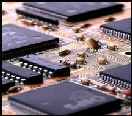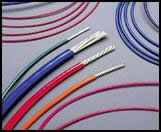Basic Information

Basic Information | Program History | Safer Product Labeling | Internships | Related Programs
Printed Version
A printed publication of this Partnership Highlights page also exists (PDF, 4pp, 1.04MB, About PDF).
The Office of Pollution Prevention and Toxic’s (OPPT) DfE Program at the U.S. Environmental Protection Agency uses the office’s chemical assessment tools and expertise to inform substitution to safer chemistries. Many stakeholders consider DfE Partnerships the forum of choice for pressing issues in chemical sustainability and an important Agency tool for implementing Green Chemistry. The partnership projects highlighted below provide an overview of DfE’s recent partnerships and their common goals of risk reduction.
Safer Electronics

The work of DfE's Lead-Free Solder Partnership will help industry to focus on products and processes that reduce solders' environmental impacts, including releases of toxic chemicals and reductions of potential risks. With annual worldwide tin/lead solder use at about 180 million pounds, the transition to lead-free solders presents a significant opportunity for risk reduction.
The electronics industry approached EPA as it prepared for compliance with the European Union (EU) Directive to phase out lead in electronics. Completed in 2005, the partnership's Life-Cycle Assessment focused on the environmental impacts of tin/lead solder and leading candidate lead-free solders. It also identified areas for further research including: developing more energy-efficient solder application equipment; resolving the variability of the available silver production inventory data to better understand the impacts of silver mining and processing; and the leachability of tin/lead alternatives.

Results of the DfE and Massachusetts Toxics Use Reduction Institute Wire & Cable Partnership's study will help companies make environmentally sound product and material choices, and will identify relative contributions of various processes and substances to the overall environmental and health impacts of the products.
Formed to evaluate the impacts of standard and alternative wire and cable formulations, the partnership is using a life-cycle assessment approach to assess heat stabilizers, flame retardants, and polymer systems used in wire and cable insulation and jacketing.
Safer Flame Retardants

DfE's Furniture Flame Retardancy Partnership is helping industry factor environmental and human health considerations into their decision-making as they choose chemical flame retardants for fire safe furniture foam.
The partnership was formed as the result of stakeholder concerns about worldwide occurrence of pentabromodiphenyl ether (pentaBDE) in the environment and human tissues. PentaBDE was the primary flame retardant used in the manufacture of low-density, flexible polyurethane foam for furniture, with production volumes of approximately 19 million pounds per year. When industry agreed to voluntarily phase out pentaBDE, the partnership's work took on a new urgency.
This broad, multi-stakeholder partnership was formed to develop and disseminate information on alternative technologies for achieving furniture fire safety standard, and completed its report in September 2005.
Printed Circuit Board Partnership
The purpose of the Printed Circuit Board Flame Retardancy Partnership is to better understand the environmental health and safety aspects of commercially available flame retardants that can be used to meet fire safety requirements for the majority of printed circuit boards.
Tetrabromobisphenol A (TBBPA) is the largest-volume brominated flame retardant with an annual production of approximately 330 million pounds, and is the primary flame retardant for printed circuit boards. Alternative flame retardant materials, developed in response to concerns over the use of some brominated flame retardants, are becoming available for use in printed circuit boards.
The partnership plans to conduct an alternatives assessment to focus on environmental and human health considerations, building on the groundbreaking methodology of the Furniture Partnership. The results, along with cost and performance information, will be used by the electronics industry in selecting flame retardants for printed circuit boards. A web site on this partnership will be available later in 2006.
Safer Formulations

DfE's Formulator Program encourages partners to reformulate products to be environmentally safer, cost competitive, and effective. By providing chemical and toxicological information and suggesting safer substitutes, the Formulator Program reduced an estimated 40 million pounds of chemicals of concern in 2005.
-
Industrial/Institutional Cleaning Partnership
Formulator Partnerships have become respected and sought-after in the Industrial & Institutional Cleaning sector. The number of companies submitting products for review has more than doubled, as has the number of newly recognized products. Many of the industry's major players are already or are in the process of becoming DfE partners.
At the industry's international trade show, DfE owned the buzz in green cleaning products, with many eager to learn more. Purchasing entities from Oregon, Washington, and Vermont now include DfE recognition in their specifications for eco-friendly products.
Consumer Products Partnership
DfE is now working with the consumer cleaning products sector. Large chemical volumes are used in this sector, with the potential for substantial population exposures. In many instances significant reformulation benefits exist.
The first major partner in this sector, SC Johnson (SCJ), shares DfE's methodology and vision for greening products by assessing all ingredients and focusing on key concerns to achieve continuous improvement. To date, DfE has recognized SCJ's Scrubbing Bubbles and several other innovative products. DfE has also partnered with Wal-Mart's Chemical-Intensive Product Network to develop sustainability scorecards for suppliers and manufacturers.
Detergent Ingredients Partnership
DfE has partnered with the GreenBlue Institute
Best Practices & Technologies

Automotive Refinishing Partnership
DfE demonstrated in its partnership with the automotive refinishing industry that developing best practices helps small businesses reduce emissions of toxic chemicals. Building on this successful approach, DfE is now working collaboratively with EPA's Office of Air Quality Planning and Standards and Regions to craft a flexible pollution prevention provision of an area source regulation.
-
Area Sources
Individually, area sources are considered small emitters, but cumulatively they present opportunities for significant emission reductions through best practices and other pollution prevention solutions. Implementation of best practices on a national level in 50,000 auto body shops would reduce releases of toxic pollutants by over 110 million pounds per year, saving auto body shops up to $650 million through reduced paint costs.
Many area sources are located near residences and schools. Emissions of concern from these facilities include diisocyanates (the leading cause of occupational asthma), heavy metals, and volatile organic compounds.
Polyurethane Foam
To realize additional public health benefits, DfE is exploring partnerships with other industry sectors, such as polyurethane foam manufacturers. DfE will help identify innovative methods to reduce emissions of air toxics, including diisocyanates. Diisocyanates have been linked to a high incidence of asthma in children living near a foam facility.
Safer Detergents Stewardship Initiative (SDSI)
Recognition for Environmental Leadership

Through SDSI, DfE will recognize companies, facilities, and others who voluntarily phase out or commit to phase out the manufacture or use of nonylphenol ethoxylate (NPE) surfactants. Both NPEs and their breakdown products, such as nonylphenol (NP), can harm aquatic life.
NP is both an intermediate in the manufacture of NPE surfactants and an ultimate degradation product. NPE surfactants are used in many sectors, including cleaning and industrial processes. DfE has identified safer alternatives to NPEs through its partnership work with industry and environmental advocates. These safer alternative surfactants are comparable in cost and are readily available.
SDSI will encourage the manufacture and use of safer surfactants, which will reduce the level of NPE surfactants and NP in streams. This initiative will help implement the Aquatic Life Criteria for NP published in the Federal Register in February 2006. The criteria were designed to protect aquatic life in both fresh and saltwater, providing the basis for state and tribal water quality standards.
From Our Partners...
"We are delighted to continue to partner with the EPA. Design for the Environment supports SC Johnson's commitment to put the environment and human health at the center of product development and formulation. Companies can and should continue to look closely at making investments that are about doing what's right for the business and the environment."
- Fisk Johnson, Chairman and CEO of SC Johnson
Read SC Johnson's news release about the partnership ![]()
![[logo] US EPA](https://webarchive.library.unt.edu/eot2008/20090508063948im_/http://www.epa.gov/epafiles/images/logo_epaseal.gif)